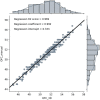Reliability and Agreement of Automated Head Measurements From 3-Dimensional Photogrammetry in Young Children
- PMID: 37307495
- PMCID: PMC10445626
- DOI: 10.1097/SCS.0000000000009448
Reliability and Agreement of Automated Head Measurements From 3-Dimensional Photogrammetry in Young Children
Abstract
This study aimed to assess the reliability and agreement of automated head measurements using 3-dimensional (3D) photogrammetry in young children. Specifically, the study evaluated the agreement between manual and automated occipitofrontal circumference (OFC) measurements (n = 264) obtained from 3D images of 188 patients diagnosed with sagittal synostosis using a novel automated method proposed in this study. In addition, the study aimed to determine the interrater and intrarater reliability of the automatically extracted OFC, cephalic index, and volume. The results of the study showed that the automated OFC measurements had an excellent agreement with manual measurements, with a very strong regression score ( R2 = 0.969) and a small mean difference of -0.1 cm (-0.2%). The limits of agreement ranged from -0.93 to 0.74 cm, falling within the reported limits of agreement for manual OFC measurements. High interrater and intrarater reliability of OFC, cephalic index, and volume measurements were also demonstrated. The proposed method for automated OFC measurements was found to be a reliable alternative to manual measurements, which may be particularly beneficial in young children who undergo 3D imaging in craniofacial centers as part of their treatment protocol and in research settings that require a reproducible and transparent pipeline for anthropometric measurements. The method has been incorporated into CraniumPy, an open-source tool for 3D image visualization, registration, and optimization, which is publicly available on GitHub ( https://github.com/T-AbdelAlim/CraniumPy ).
Copyright © 2023 The Author(s). Published by Wolters Kluwer Health, Inc. on behalf of Mutaz B. Habal, MD.
Conflict of interest statement
The authors report no conflicts of interest.
Figures






References
-
- Gale CR, Walton S, Martyn CN. Foetal and postnatal head growth and risk of cognitive decline in old age. Brain 2003;126:2273–2278 - PubMed
-
- Ivanovic DM, Leiva BP, Pérez HT, et al. . Head size and intelligence, learning, nutritional status and brain development: head, IQ, learning, nutrition and brain. Neuropsychologia 2004;42:1118–1131 - PubMed
-
- Gale CR, O’Callaghan FJ, Bredow M, et al. . The influence of head growth in fetal life, infancy, and childhood on intelligence at the ages of 4 and 8 years. Pediatrics 2006;118:1486–1492 - PubMed
-
- Rijken BFM, den Ottelander BK, van Veelen MLC, et al. . The occipitofrontal circumference: reliable prediction of the intracranial volume in children with syndromic and complex craniosynostosis. Neurosurg Focus 2015;38:E9 - PubMed
MeSH terms
LinkOut - more resources
Full Text Sources

